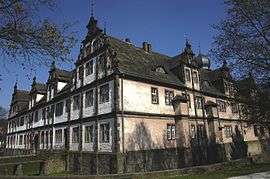Brunswick-Bevern
Brunswick-Bevern was a secundogeniture of the Younger House of Brunswick, itself a branch of the House of Welf.

Its first member was Ferdinand Albert I of Brunswick-Lüneburg (1636–1687), the fourth son of Duke Augustus the Younger, ruling Prince of Brunswick-Wolfenbüttel. Upon the death of his father in 1666 and a lengthy dispute with his elder brothers, Ferdinand Albert I received Bevern Palace near Holzminden as part of his inheritance. In turn, he had to waive all rights and claims to rule in the Welf Principality of Brunswick-Wolfenbüttel.
Nevertheless, the Bevern line came to power in the Principality of Brunswick-Wolfenbüttel when the main line of the Younger House of Brunswick became extinct with the death of Duke Louis Rudolph in 1735. Ferdinand Albert II, fourth son of Ferdinand Albert I who had succeeded his father in Bevern in 1687, ascended to the throne. At that time, he passed the appanage of Brunswick-Bevern to his younger brother Ernest Ferdinand (1682–1746), who thereby became head of the Younger Brunswick-Bevern line. His sons Augustus William and Frederick Charles Ferdinand held the secundogeniture until 1809. The main Brunswick-Wolfenbüttel line became extinct with the death of Duke William in 1884.[1]
Dukes of Brunswick-Bevern
- 1666-1687: Ferdinand Albert I
- 1687-1735: Ferdinand Albert II
- 1735–1746: Ernest Ferdinand
- 1746–1781: Augustus William
- 1781–1809: Frederick Charles Ferdinand
References
- Braunschweig-Bevern at www.zeno.org. Accessed on 9 Oct 2010.